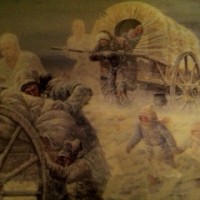
A History of Moving
Just 39 years ago in 1973, a massive fire in Overland, Missouri consumed a large amount of U.S. History. The fire burned for two days, feeding off of cardboard boxes in the federal government’s Military Personnel Records building. Recorded history dating back to 1841, World War I, World War II, and the Korean War was destroyed or severely damaged according to the National Archives and Records Administration (NARA). It is and, hopefully, always will be considered the most devastating archival fire in U.S. History.
The most devastating archival fire has called for the largest archival move in U.S. history many years later. A crew for Graebel will complete the 18-month relocation of these damaged but salvageable historical records along with non damaged historical files to the National Personnel Records Center in St. Louis.
More than 500,000 files have been relocated since 2010, some of which take special handling. Papers that are covered in mold and mildew require the crew to wear respirators to breathe. Besides the obvious health issues, the confidentiality of the records is most important. The brittle-burn records are among records of high-profile veterans like politicians, actors, athletes, and musicians who have served the country. Some archives are of such high historical significance that the moving trucks are escorted by a motorcade.
Because of the significance and confidentiality of the records, all Graebel crew members had to undergo government security clearance and background checks to do the job. The company had to have already acquired a Certificate from the General Services Administration. Graebel was assigned to the job due to their technical knowledge, leadership, price, and experience, according to CEO Bill Graebel. The company had successfully completed previous NARA relocations in Atlanta and St. Louis.
Graebel introduced the skills needed for the job. “The key to squeezing out variation on a job is making sure that each employee assigned to the project has the experience and understands chain of custody protocols and the relocation workflow. Everyone involved has to have a clear idea of their role, the proper tools for the project, and, above all, the client’s expectations.”
It is not an easy, every day kind of job. The team researched custody requirements work-flow designs, and developed strategies to ensure smooth relocation. This type of work leaves no room for error. They worked on tight schedules and had to synchronize everything just as the employees needed.
Along with the relocation of the records, 800 employees’ office furnitures needed to be moved at the same time as the records they were working with. That lead to about 6,000 boxes being moved a day and being placed just so in the new facility.
Gary Paul, regional vice president and general manager of the Graebel center in the greater St. Louis market, emphasized the importance of precision on this job. “One box out of order could be a catastrophe. It has to be all in succession. One box misplaced out of 2 million would make it nearly impossible to find something. Miscalculations could have been dire.”
Graebel even had to design a lightweight moving cart that was capable of navigating the catwalk in the largest shelving system at the NPRC. The company rose to every challenge the relocation handed them.
Paul and Graebel said that being part of the relocation of the military documents in St. Louis has been both humbling and gratifying. All members of the team considered it an honor to serve the veterans that the records represented.
“We were not just moving boxes, but moving memories of servicemen and -women.”


















2 Responses
…A Friend recommended your blog…
[…]I am now not sure where you are getting your info, however good topic.[…]…
Junk removal is quite an intriguing business idea for sure and owing to the huge amount of junk present in almost every home, it sure would generate huge profits. In addition, you can also expand your business by recycling the plastic or metal waste.